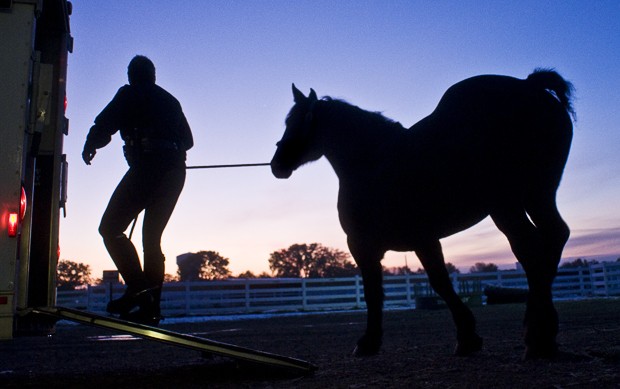Getting a speeding ticket isnâÄôt often something motorists usually laugh about, but when the officer writing the ticket does it from horseback, reactions may vary. âÄúPeople get a kick out of it,âÄù said University of Minnesota police officer Jessica Mendel, who rides a horse as part of the University policeâÄôs mounted patrol. âÄúItâÄôs not too often in a squad [car] that you get thanked for a citation,âÄù said University police officer Marianne Scheel, who is also a full-time officer with the mounted patrol. Beyond the novelty of giving traffic citations from horseback, horses have been a critical part of the University police force since they were added in 2005. In addition to Scheel and Mendel, three UMPD officers work mounted patrol part time, Scheel said. Mounted patrols can go places that squad cars canâÄôt, are faster and have a better ability to control crowds than officers on foot do. A 7-foot tall, 1,500 pound animal has a presence that no single officer could achieve. âÄúOur fellow officers appreciate it,âÄù Scheel said. âÄúTheyâÄôll call us if it looks like something is getting out of hand. They would much rather have the horses push into a crowd than them having to do it on foot.âÄù They also have an imposing presence that makes them more visible, which police say deters criminal acts and gives the officers riding them a distinct advantage during crowd control. During a protest in 2006, protestors poured paint on the Washington Avenue Army recruiting office, but it splashed back on the crowd, making it impossible for police to later identify the suspected parties, but University police on horseback towered above the rows of protestors and saw the act, something they could not have done from foot. To prepare the horses for the stimuli they might encounter during police work, officers expose the horses to the mundane things that might normally frighten them. During training, officers will force the horses to forge sandboxes, plastic tarps, stairs and mattresses and will toss plastic shopping bags at them. Officers also fire blank pistol rounds while atop the horses and swarm around them to better acclimate the horses to crowds they might encounter. The officers themselves also have to adapt to the changes brought on by being on horseback. Because it is difficult to control the horse from the ground, officers avoid dismounting except in emergency situations. They practice writing tickets, issuing commands and firing weapons from horseback and may spend six hours a day in the saddle while on a normal patrol. Of UMPDâÄôs horses, Casey, a stout plump Percheron who pulled wagons before being enlisted for police work, is dominant. By contrast, Louie, a bay Thoroughbred, is a lithe and regal horse who matured on the racetrack in Kansas City. The officersâÄô preparation for a mounted patrol begins long before the horsesâÄô shod hooves ever strike the ground outside the Equine Center. The officers brush and feed the horses. When combing their manes and tails, the officers brush away any straw and mud that might have caked on the horsesâÄô backs as they rolled and frolicked during the night. Then they scrape any mud or straw from the horsesâÄô hooves and ankles. Louie, whose wineglass stem of a hind left leg is wrapped in a band of clean white hair, needs special attention to be kept presentable. A third UMPD horse, Whisper, has been convalescing from a broken elbow for almost a year and is close to returning. While the injury was serious, the staff at the Equine Center provided care for Whisper, as they do for the other two UMPD horses. Technicians at the center and veterinarians care for the horses as needed. For their part, the officers speak to tour groups at the facility whenever possible. âÄúWeâÄôre very happy to have them âĦ itâÄôs a win-win for both sides,âÄù said Kelly Vallandingham, community liaison for the Equine Center. The horses inspire curiosity in almost everyone who sees them, but they generate the most interest in children, Scheel and Mendel said. âÄúWe use that not only as an opportunity to talk to kids about the horses, but to talk to them about safety,âÄù Scheel said. During one normal patrol in the summer of 2008, Scheel and Mendel met a young girl named Rachel Mattson, who was staying at the Ronald McDonald House. Mattson told the officers that if she ever had a chance to participate in the Make-A-Wish Foundation program, she would ride a horse. The officers put her in the saddle of a horse later that same day. The mounted officers will continue to ride throughout the football season, but mounted patrols will stop in November when the weather and narrowly-plowed sidewalks make being on horseback difficult and impractical. The horses will go back to their paddock at the Equine Center, and the officers will resume their regular patrols. âÄúI will be happy to get back into the squad car with heat,âÄù Mendel said. Still, the horses are not entirely done for the year. Weekly training continues throughout the winter months.

UMPD Officer Marianne Scheel escorts her horse, Casey, into a trailer Tuesday early morning to be transported to the Minneapolis campus area.
Mounted patrols increase police coverage
Mounted patrols, which can go places squad cars can’t, are critical to crowd control and help improve public relations.
by Ian Larson
Published October 13, 2009
0

